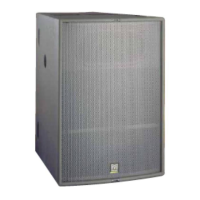Wind gradient
Air movement is slowed by friction so wind is usually lighter near the ground than it
is higher up. Ground level wind speeds can vary from over 90% of the main wind
speed in the daytime, when the air is being mixed by being warmed by the ground, to
under 30% at night, when air - cooled by the ground - looses buoyancy.
This varying wind speed with height is called the wind gradient.
A wind gradient associated with wind blowing towards a loudspeaker will "slow" its
vertical wavefront differentially. The vertical wavefront will be slowed less near the
ground and its sound path will veer upwards.
Conversely, a wind gradient associated with wind blowing from behind a loudspeaker
system will "speed up" its vertical wavefront differentially. The vertical wavefront
will be speeded up less near the ground and its sound path will veer downwards.
30m
20m
10m
0m
0m 10m 20m 30m 40m 50m 60m 70m 80m 90m
Wind Stronger
Wind Weaker
Sound path tilting upwards outdoors due to wind
blowing towards loudspeakers
30m
20m
10m
0m
0m 10m 20m 30m 40m 50m 60m 70m 80m 90m
Wind Stronger
Wind Weaker
Sound path tilting downwards outdoors due to wind
blowing away from loudspeakers
All material © 2007. Martin Audio Ltd. Subject to change without notice.

